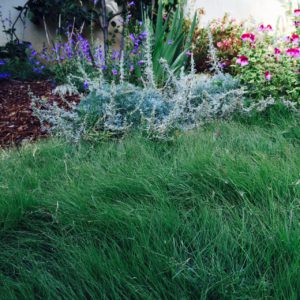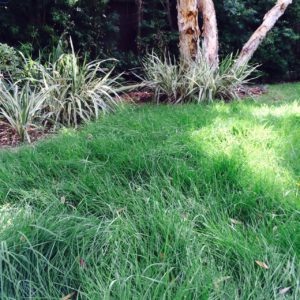A lawn for our ever-parched climate
Recently there’s been much “ado” about the drought but if you’ve been a Californian all your life it can seem that we’ve been in a perpetual drought. We’ve been supporting a non-sustainable model for decades in Los Angeles by supporting our lush, water-hogging landscapes with water piped in from afar. They say about 1/2 of the water we use goes to the landscape so not only must we reduce the water we use, we then need to make every drop count by choosing the right plant material. Lawns are beloved for their cooling effect, their functionality as a place of play and transition and they provide a nice visual element. In terms of water savings, however, a critical eye must be taken to every lawn and the following questions should be asked….
1.) Do I use my lawn? If the answer is no then perhaps a native ground cover is a better choice or a mix of low water plants and permeable hardscape.
2.) If I indeed use my lawn do I really need all that I have? If the answer is no, why not reduce the lawn by widening other planting areas.
3.) Can I replace what lawn I have with a lawn that requires less water? I’m not going to call them lawn “alternatives” because they are lawns in their own right and they are much better adapted to our hot, dry climate. Below are the top contenders for lawns for our ever-parched climate…
UC VERDE BUFFALO GRASS: This light green, thinned bladed grass is very comfortable to sit or walk on. Left un-mowed the grass reaches 4-8″ but can be mowed to your desired height. It is sold in “plugs” which are typically planted anywhere from 8″ to 12″ apart. The plant spreads by stolons and prefers full sun. The best time to plant is during the active growth season which is spring and summer. From about December through March the grass will go dormant (less so in warm winters) and take on a tan color. Special attention must be made at planting time to remove all weeds and previous turf and to stay on top of weed removal as the grass fills in. Buffalo Grass is super thrifty on water saving about 75% of the water used on a traditional turf.
NATIVE BENTGRASS (Agrostis Palens): This emerald green, medium blade grass is also very soft. Bentgrass spreads by underground rhizomes and can withstand low mowing heights or be left to grow into more of a meadow look with mowing only every 3-4 weeks. This grass is happy in full sun but can take a little shade. It’s available in sod or seed and can be planted anytime during the year, however, it is easiest to establish if planted in the fall. Proper, deep watering is important to establish a deep root system during the first year and then the grass will only need about half the water of a traditional turf. This grass will go dormant in the summer unless water is provided.
There are other species being used as lawn replacements such as Carex pansa or Carex praegracilis. These lawns do save some water (about 25%) but they form tufts and are not as easy to walk on as the above options.
Lawn removal and replacement is a big investment so it’s important to get advice from a professional who focuses on sustainable landscapes as to what type of grass will work best in your situation. Besides saving water these lawns are pest and disease resistant (so no herbicides or pesticides), require only a minimum of fertilizer or compost tea and require less mowing. Everybody wins with these great grasses!
For more information contact Satori Garden Design




Pamela Wheeler
November 5, 2014 at 11:58 pmJust moved to a new home in Waxahachie,TX. Absolutely no lawn & am interested in drought resistant lawn. Open to any & all suggestions